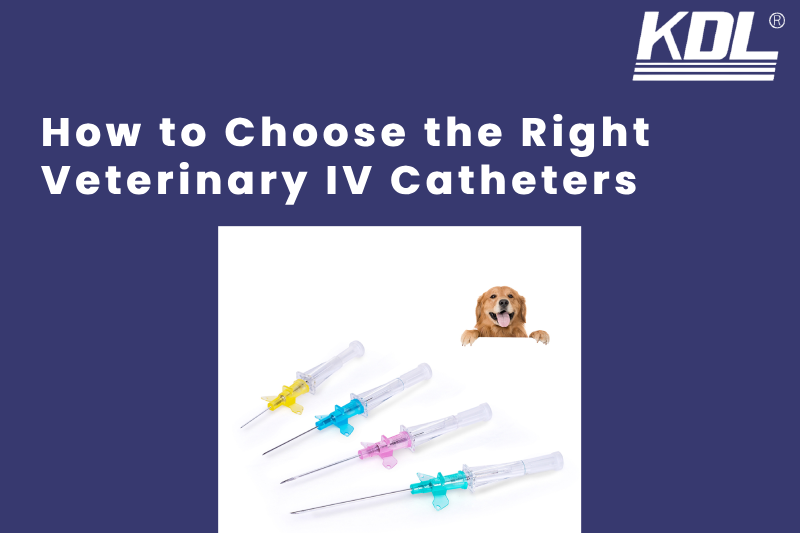
In veterinary care, every decision can make a big difference in the health and well-being of animals. One of these important choices is selecting the right Veterinary IV catheters for your veterinary practice. IV catheters are essential tools that allow veterinarians to administer fluids, medications, and other treatments directly into an animal’s bloodstream. With so many options available, it’s important to know how to choose the best one for your needs.
Factors to Consider When Selecting Veterinary IV Catheter
When picking the right IV catheter, there are several factors to keep in mind:
- Size: The size of the catheter matters. Smaller animals, like cats or small dogs, need smaller catheters, while larger animals, such as horses, require larger ones. The right size ensures that the catheter works effectively without causing unnecessary discomfort or injury to the animal.
- Material: IV catheters are made from different materials, such as polyurethane or Teflon. Some materials are more flexible, making them easier to insert and more comfortable for the animal. Others are more rigid, which might be needed for certain procedures. Consider the type of procedures you perform most often when choosing the material.
- Duration of Use: Some IV catheters are designed for short-term use, while others are meant to stay in place longer. If you need a catheter for a quick procedure, a short-term catheter is ideal. But if you need one to stay in place for several days, look for a catheter designed for long-term use to minimize the risk of infection or other complications.
- Animal’s Condition: The health and condition of the animal also play a role in your choice. For example, animals that are very sick or dehydrated might need a different type of catheter than healthy ones. Always consider the specific needs of the animal before making your decision.
Types of Veterinary IV Catheters Available in the Market
There are several types of IV catheters available, each with its own benefits:
1. Over-the-Needle Catheters: These are the most common type used in veterinary practices. The catheter is placed over a needle, which is then inserted into the vein. Once the catheter is in place, the needle is removed. These are usually used for short-term procedures.
2. Through-the-Needle Catheters: These catheters are threaded through a needle that stays in the vein. They are typically used for longer procedures or when frequent access to the vein is needed.
3. Central Venous Catheters: These are inserted into a large vein, often in the neck or chest area. They are used for long-term treatments or when multiple medications need to be administered at once.
4. Peripheral IV Catheters: These are placed in smaller veins, usually in the limbs. They are often used for short-term treatments or when only one medication is being administered.
Read More : Veterinary Hypodermic Needles: A Guide to Types and Uses in Animal Care
Choose Top Manufacturers of Veterinary IV Catheter
When it comes to veterinary IV catheters, there are several top brands and manufacturers to choose from. KDL is top manufacturer of veterinary IV catheter are known for their high-quality products and reliable performance, making them a top choice for many veterinary professionals.
Tips for Proper Handling and Maintenance of IV Catheter
To ensure the safety and effectiveness of IV catheters, proper handling and maintenance are crucial:
- Sterility: Always maintain a sterile environment when handling IV catheters. This reduces the risk of infection and ensures that the catheter functions properly.
- Insertion: Make sure the catheter is inserted correctly and securely. Improper insertion can lead to complications such as leakage, swelling, or discomfort for the animal.
- Monitoring: Regularly check the catheter for any signs of infection, blockage, or displacement. If any issues arise, address them immediately to prevent further complications.
- Replacement: If the catheter is meant for short-term use, remove and replace it as recommended. For long-term catheters, follow the manufacturer’s guidelines for maintenance and replacement.
Common Mistakes to Avoid When Using Veterinary IV Catheters
Even with the best intentions, mistakes can happen. Here are some common mistakes to avoid:
- Choosing the Wrong Size: Using a catheter that is too large or too small can cause discomfort and reduce its effectiveness. Always select the appropriate size for the animal.
- Neglecting Sterility: Failing to maintain a sterile environment can lead to infections. Always wear gloves and use sterile equipment when handling IV catheters.
- Improper Insertion: Inserting the catheter incorrectly can cause damage to the vein or surrounding tissue. Take your time and ensure the catheter is placed correctly.
- Ignoring Signs of Complications: It’s important to monitor the catheter site regularly. If you notice any redness, swelling, or discharge, address it immediately to prevent serious complications.
Conclusion
Choosing the right veterinary IV catheter is a vital part of providing quality care to animals. By considering factors such as size, material, and the specific needs of the animal, you can ensure that you’re making the best choice for your practice. Remember to handle and maintain the catheters properly, and avoid common mistakes to keep your patients safe and healthy. With the right knowledge and tools, you can provide the best possible care for the animals in your practice.
 +86-791-8686-1216
+86-791-8686-1216 

